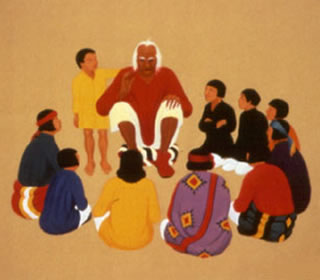A couple of recent pieces have examined the role of relationships and connections in storytelling.
In a scholarly piece called Different Ways of Remembering: the Example of Storytelling, Mark Oppenneer writes:
The telling of a story not only suggests the physical presence of a storyteller and an audience, but the relationship that exists between the two, the relationships between members of the audience, the relationship between humans and the land on which they live and in which the action of the story transpires, etc.
Oppeneer notes that the tendency to see “story” as text is a “Western information bias,” and Westerners tend to find audio and video recordings “sufficient to capture the telling of a story.” But such manifestations of story strip away “essential components of relationship,” Oppenneer asserts.
Laura S. Packer views storytelling and relationships from a different angle in Storytelling as connective tissue:
…[T]he shared experience of listening to a story makes the entire audience into one being. The story is the ligament that binds us. … Regardless of the length of the story, the setting in which it’s told, the experience of the teller or the teller’s background, when we tell authentically tell a story it binds audience members to each other and to the teller. Stories are connective tissue in culture and families as well. They are how we identify ourselves, how we know that I am of this group, so this is my story.
Both authors stress this connective role of storytelling in the act of re-telling. For Packer, listeners “know who they are by the stories they were told and in turn retell.” Oppenneer notes:
..[T]he telling of a story interacts with prior tellings remembered by the audience and is infused with embellishments and improvisations that are in tune with the relationships established during the performance.
and he quotes Rebecca Green: “Repetitive storytelling of the past re-creates, solidifies, and even creates the veracity of events and individuals.”
The underlying message for both authors is that storytelling creates cultural identity, cultural memory, cultural meaning, and knowledge that is passed on from person to person, generation to generation.
As technology provides us with more and more ways to tell stories, we would be wise to ask ourselves the extent to which any given storytelling medium enables us to preserve relationships
I love the words Packer closes with:
Stories reach across time, space and distance to give us the same narrative connection. We are human. We tell stories. Listen to me and I will listen to you: We will recognize ourselves in each others words.
